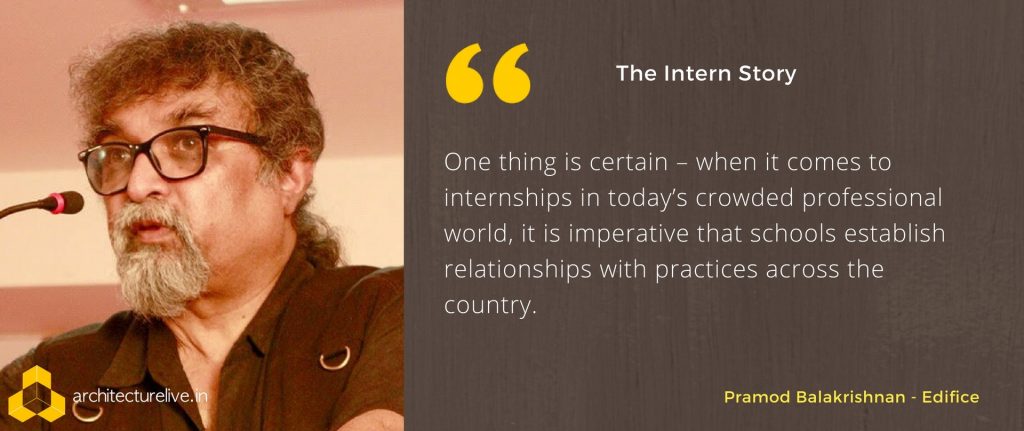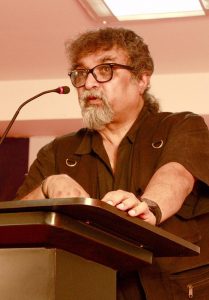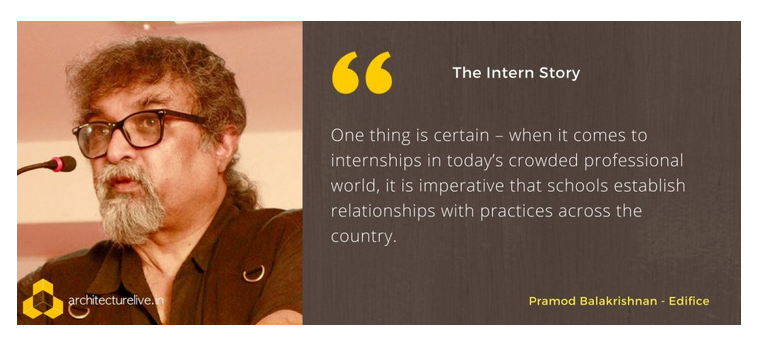Student internship is a quintessential part of an architectural education. However, it is increasingly becoming an unmitigated ordeal for many within the community. Affecting both students and practicing architects, the workforce imbalance and issues of ineptitude have created an unfavourable – and often exploitative – situation.
Inviting the opinions of architects, educators and students, we strive to start a conversation about what can be done to improve this situation. Below, Pramod Balakrishnan of Edifice share his opinions about the issue.

I have a completely different perception of internships; it is what we have implemented at Edifice for over ten years, and have been adding and changing as we go along.
Crunching the Numbers
We have too many schools – and with it, too many students. Internship is something that everyone has to undergo.
Typically, we get over three hundred applications every semester. Not many students, however, know how to address and convey. Furthermore, all portfolios look the same; one wonders what – if anything – are the young ones learning. But I go through each application and try and reply to all of them. Many students write to all and sundry in one mail. They receive no acknowledgement – I don’t think it matters to them.
So, how do we choose eight to ten of them every semester?
Firstly, we choose many from outside the state and the city – only about two from within Chennai. We do so to get a good mix of students, so they can learn from each other. We also attempt to get all of them to join the program on the same day.
Breaking the Mould
It is important to remember that all through life these kids have always been instructed and evaluated. In the process, most become doers and lack the ability to think for themselves. What they are taught in schools makes them problem-solvers and plan-makers – they understand the process of design as being linear.
At Edifice, we attempt to break this sequence. We want them to think for themselves, judge themselves. We want them to look within and see who they really are.
For this purpose, we do many open-ended exercises without disclosing the intent and destination.
Reading is an important part of internship. We select books for each one of our interns. We only want them to be comfortable with reading – they needn’t read cover to cover, or remember every detail. One should read as one wishes – perhaps jot down observations or questions, as they like. Further, we discuss the books as per each person’s attempts. The motive is to share, question and learn.
There is a philosophy to the work at Edifice. Accordingly, we initially give interns selected projects to review – to abstract them, to try and see if they can work backwards to reach the original thought. We encourage them to discuss these projects with the architect, as well as take them on several site visits to these projects. From drawing to building, and back.
Learning to Think
Interns, further, work on understanding materials and recording them. At site visits, they are to see the various materials used across the project, understand the details, and add on to the collection. This is something we hope grows with them through time.
They, then, are slowly led into making detail drawings of projects – a staircase, toilets, joinery, flooring, and the like. Then they progress onto presentation drawings of live projects, working drawings of small projects, etc.
After this, they get to design a live project that the office has received. They begin by putting down their intentions, exploring the context, and charting the climate. Then starts the design process, which is discussed with the office. The scheme developed by the office is also discussed and debated.
Finally, they are all packed off to Hampi. They plan their own five-day trip. The objectives are simple: learning to live with each other, understanding the dynamics of positions, likes, dislikes etc., and wander through the place and decide together on what to do next. When they come back, they are required to present their trip to the office.
We also show movies every Friday. From architecture to nature to technology and so much more – no topic is left untouched. Discussions are held afterwards to help in the process of communication and articulation.
Charting the Growth
Everything is left to the interns, basically, when it comes to how far they want to go. Our process provides immense potential for self-development. They learn so much about themselves, about communicating, about being critical of their own work, and standing up for what they’ve presented. And no one judges them, except themselves.
The portfolio is being put together throughout the internship. Many of our interns score poorly in their college viva because they do not have the prerequisite working drawings to show – but many come out happy regardless, as they are content with what they have leant.
We understand that students don’t have the knowledge they should possess, at the start of an internship. However, we are not worried, because it’s not their fault – it is the pathetic state of education in most schools.
We look at each of the eight to ten of them as clay that needs a little wetting to open to their minds. We do not care if they do not work at the office – but we do care that they begin to think. Our success lies in the fact that more than 80% of the interns are happy during the internship, and are learning and growing.
We never use the interns to work on our projects solely for deliverables. They are not considered cheap labour, and are paid a stipend.
What Can Be Done?
The problem right now is that institutions don’t take responsibility. Many schools don’t have a vision; when asked what skills their students should possess after five years, they have no clue.
Many offices, sadly, use interns as cheap labour. They make students do mundane work – even make coffee and get food – and make them work late hours. Many interns never meet the architect even once, and work under some team leader or junior. I find all of this very disappointing. Both schools and professional practices have to change their attitudes; otherwise, we are a lost profession.
- Schools of architecture must first have a vision. They should know what it is that their students will be empowered with when they leave the portals – this is what sets an institute apart from another.
- Many students do not know about the various firms in the country and the kind of the work they do. Schools need to collate information about professional practices – including links to their work – and put them in libraries. Ideally, they should maintain a roster of institutes for students to choose from when applying.
- Students must also be guided about the application process. Writing a cover letter, for example, requires skill, and should be tailored to the office being applied to. Schools should coach their students in these areas.
- Schools must – after each year’s period of internship– assess what each practice provided their students with. If it does not align with their vision, then perhaps those practices can be taken off the roster. For practises which do fit in, institutes can talk to them about expanding the opportunities available.
- Finally – the monthly reports that students are required to submit don’t reveal any useful information. If, however, these assessment forms were centred on the institute’s specific vision, the results would be worthwhile.
One thing is certain – when it comes to internships in today’s crowded professional world, it is imperative that schools establish relationships with practices across the country. If possible, institutes can try and talk to practices and arrange for some placements every year. Internships are their responsibility, as it is a part of the curriculum.
I do not know whether or not all of these can be implemented, given the morass that we sliding into. But it is certainly necessary that we try.
 Pramod Balakrishnan graduated from CEPT Ahmedabad in 1981. He started his career with short stints at offices in Ahmedabad before moving to work in Kuwait, where he pioneered projects all over the Middle East. He returned to India in 1985 and set up Edifice in 1987. A guest faculty at several architectural colleges, he is also a member of the Board of Studies of three colleges in Chennai. He is a senate member at the SPA Vijaywada, and is also a founding member of The Chennai Architecture Foundation that works to discourse on architecture, the city, education and allied creative fields.
Pramod Balakrishnan graduated from CEPT Ahmedabad in 1981. He started his career with short stints at offices in Ahmedabad before moving to work in Kuwait, where he pioneered projects all over the Middle East. He returned to India in 1985 and set up Edifice in 1987. A guest faculty at several architectural colleges, he is also a member of the Board of Studies of three colleges in Chennai. He is a senate member at the SPA Vijaywada, and is also a founding member of The Chennai Architecture Foundation that works to discourse on architecture, the city, education and allied creative fields.









3 Responses
So true ! Internships should be a unlearning experience which would be reading books to critics of projects with discussions and self realisation with the realities unlike the majority who treats them as a labour with overloaded work each day , making it monotonous and concealing the thinking process of the students and ending upto a disaster future ! It should change . A mandatory change needed for a better future and effective architects .
Wow , true sir!
I’m very proud of you sir, Keep up your excellent service as we required more from you! Good!